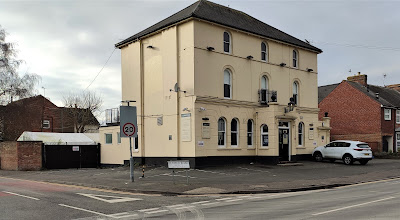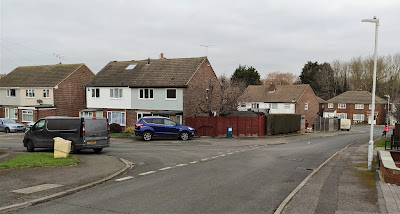They say that you should never go back and whilst that is something I have not always adhered to; I feel there is more of a grain of truth in this adage. This post, and the pub-related ones that follow, is an account of last Friday’s return visit to Ashford, made in the company of son Matthew who was perhaps, rather less enthused than I was, at re-visiting the town I grew up in.
I spent my formative years in or around the Kentish town of Ashford. My parents had moved to the town in 1959. I was 3½ years old at the time, whilst my sister was around 18 months. We had moved from London, in search of a better life, trading the cramped rooms the family shared with my paternal grandparents, as well as dad’s brother and his family, for the joys of life in an expanding Kentish town, and the luxury of a new-build, three-bedroomed, semi-detached house.
The fact they were able to make the move, was due to my father working for the Royal Mail, or the GPO as it was in those days. Dad had been able to get a transfer from the London office he was based at (I never did find out which one), to the Crown Post Office in Ashford. Our spacious new abode was a new-build Taylor Woodrow property, on an estate on the edge of the rapidly expanding village of Willesborough.
It wasn’t that far to walk into Ashford, from where we lived, although to shorten the journey time, dad preferred to cycle to and from work. He also had a motorbike and sidecar combination, for transporting the family around.Moving from the familiar surroundings of northwest London to a provincial town, must have been a real culture shock to both my parents, more so for my mother who was not only missing the support of her parents, but was left in the house all day, whilst my father was at work.
I also gather that with a mortgage to pay, money was tight, certainly to begin with. It’s hard to comprehend now, especially as the sum borrowed was a mere £2,000, but everything is relative. We didn’t really go without though, and living just a short drive to the coast, meant trips to the seaside were plentiful. Also, as dad’s position within the Royal Mail advanced, he was able to install central heating, erect a garage and buy a car – a converted Austin A35 van.
Despite there being three years difference in our ages, my sister and I attended the same primary school, starting off at the newly built infants’ school, before transferring at the age of seven, to the junior school, about half a mile away. At the age of 11, I secured a place at the nearby Ashford Boys Grammar School, where I remained for the next seven years.

Leaving Brook for another day, it was the our old house at Willesborough, the schools I attended and the town in general, that prompted the return visit to Ashford, 48 years after flying the nest to attend university and make a life for myself. Ashford is a bit of a pain to get to by road, and with the Brexit-related, traffic issues, affecting the M20 motorway, best avoided at the moment. Instead South East Trains will transport you in speed and comfort, to Ashford, following the most direct route possible, from Tonbridge, along what is claimed to be the longest straight stretch of track in the UK.
So, with a journey time of just 40 minutes, letting the train take the strain, was a "no-brainer," particularly to someone with an “Old Git’s” Railcard. I met Matthew outside the station, as I’d had some financial business to attend to in Tonbridge, first thing. There is a half-hourly service to Ashford, and the 10.52 train that we boarded, allowed sufficient time to look around, before we even thought about pubs, beer, and something to eat.
The station calls itself Ashford International, even though very few Eurostar trains stop there anymore. Having cross-channel passenger trains calling there, was always something of a white elephant, and whilst I have made three return Eurostar journeys from Ashford, the opening of another international station at Ebbsfleet, rendered Ashford more or less redundant. Ebbsfleet itself was another white elephant and, with its so-called “Thames Gateway” connection, something of a vanity project as well.

We crossed over and walked up through the town’s War Memorial Gardens, and then through the Vicarage Lane car park, at the back of the Odeon. The latter was another place where I spent much of my youth, and whilst the Odeon is still standing, it has been closed for years and under threat of redevelopment. With its almost intact, art-deco interior, there is a long-running campaign to save it but given the track record of Ashford Borough Council (ABC), I don’t see much chance of its success.
And so, following the alleyway at the side of the cinema, we arrived in Ashford High Street, a wide, attractive, and once bustling thoroughfare, befitting of a busy and successful, market town. Now it is just another pedestrianised precinct, with a few sad-looking shops, and equally sad-looking inhabitants.
A quick word then about ABC, a body that surpassed even the Luftwaffe in its appetite for the mass-destruction of any buildings of character, but with a peculiar desire for the elimination of the majority of Ashford’s stock of once thriving public houses. The local authority worshiped the motor car and it worshiped modernism, as not content with the bypass taking the A20 around the town, the council decided that Ashford needed a ring road as well. Then, on top of the ring road, the High Street shops needed a service road behind them, so that deliveries wouldn’t conflict with their plans for pedestrianisation.
The ring road involved the widening of existing roads and enhancing the junctions, and as pubs are often sited on street corners, Ashford’s stock of licensed premises took a severe hit. A substantial number of the surviving pubs disappeared following the construction of a modern shopping centre – what our American friends would call a Mall. This involved the demolition of a swathe of Victorian properties, including shops and public houses, the centre of town. To say that the County Square shopping mall tore the heart of Ashford, would be an understatement, but the council hadn’t finished yet.
Mining consortium Charter Consolidated were allowed to construct a massive 9-storey office block in the centre of Ashford. What made things worse was the building was “Y” shaped, so there was no getting away from this ghastly monstrosity, as it as visible from all directions. Even worse was the destruction of one of Ashford’s best surviving pubs, to make way for a service road for the building. So, not only was the multi-room, Lord Roberts one of the town’s best and most characterful public houses, it was also my favourite place for enjoying a beer – a view shared by many of my friends.
Fortunately, one of the only parts of Ashford to escape the wreckers’ bulldozers, were the houses surrounding the churchyard of St Mary’s Parish Church. This oasis of tranquility and antiquity is Ashford’s showcase in the heritage stakes, with almost a dozen listed building, including one housing the town museum. This tiny area illustrates what might have been, or what could have been, if a more sympathetic and sensitive council had been in charge during the 60’s and 70’s.
Time was getting on and Matthew and I were getting thirsty and hungry. My plan was to take a bus, alight outside my old school, and then walk along to have a look at what was the family’s first house. We jumped on service bus C, which runs at regular intervals, from the town centre, out to the area’s main hospital – the William Harvey. After getting off, we passed the Fox, the pub that my grandfather liked to visit, when him and my nan came to stay. Apart from a paint job, and the acquisition of the prefix “New,” it didn’t look much different. My old school, on the other hand, had been renamed, after its founder, and had also increased in size.
We continued towards our goal, but what seemed like a lengthy walk at the age of eleven, turned out to be nothing more than a stroll, and it wasn’t long before we reached the estate where the house is located. The property didn’t look a lot different, as apart from a set of replacement UPVC windows, and a new garage, not much had changed.
This is the bit at the beginning of the article which advises, not to go back, although if I’m honest, apart from satisfying my curiosity, I didn’t feel much in the way of emotion. It was good to see that from the outside, the house had been well cared for, but houses were well-built, back in the 1950’s so there wasn’t much that could have gone wrong.
I wasn’t temped to knock on the door, explain who I was and request a look around, as that would have been far too embarrassing for all concerned. Matthew would never have forgiven me either, so we continued on our way, climbing up the aptly named Windmill Close, towards the local landmark that is Willesborough Mill. The path I had planned to take though, was blocked off, so we headed in the opposite direction to Hythe Road.
 |
| Stephen Nunney / Willesborough Windmill / |
School was Willesborough County Primary School, and its mainly Victorian stone buildings are still standing at the top of Silver Hill. The school itself, has moved to a new site complete, with all modern facilities, and the original buildings converted to domestic use. We carried on by them, passing under the M20 motorway which has absorbed the former bypass.
Our lunchtime stop was just a few hundred yards away now, but I’m afraid you will have to wait for the next post to find out what it was called, and what it was like.














3 comments:
I've had time to explore Ashford a bit since Christine bought that caravan in Rye. Ashford isn't great, but there's a new GBG entry this year (Matches, a sports bar near the station) and Low Key Tap is a low key version of Fuggles you'd enjoy.
Thanks Martin, I find the whole concept of a "sports bar" off-putting, even though I’m not really sure what it means. The Low Key Tap sounds much better, although I’m unlikely to be visiting Ashford, anytime soon.
A sports bar is basically a room full of TV screens showing sports, sometimes more than one at the same time. Quite rare in this country, where a town centre pub like Tonbridge's Station House is as close as you get to the extreme version you see in the States !
Post a Comment